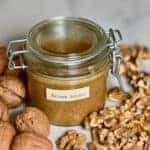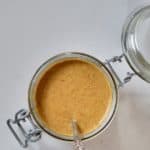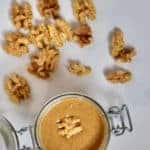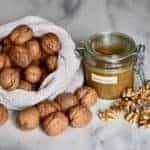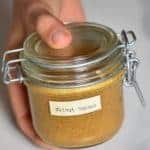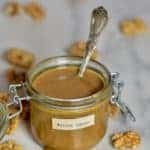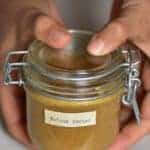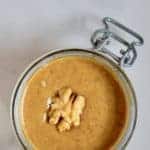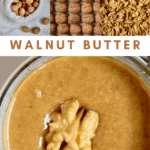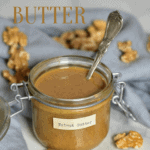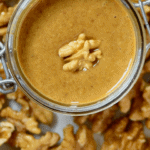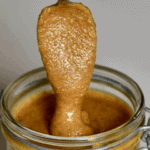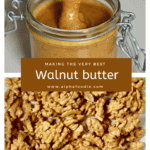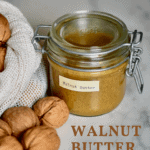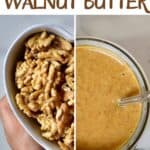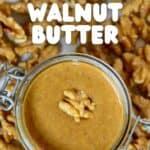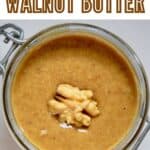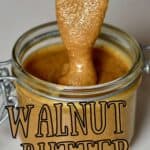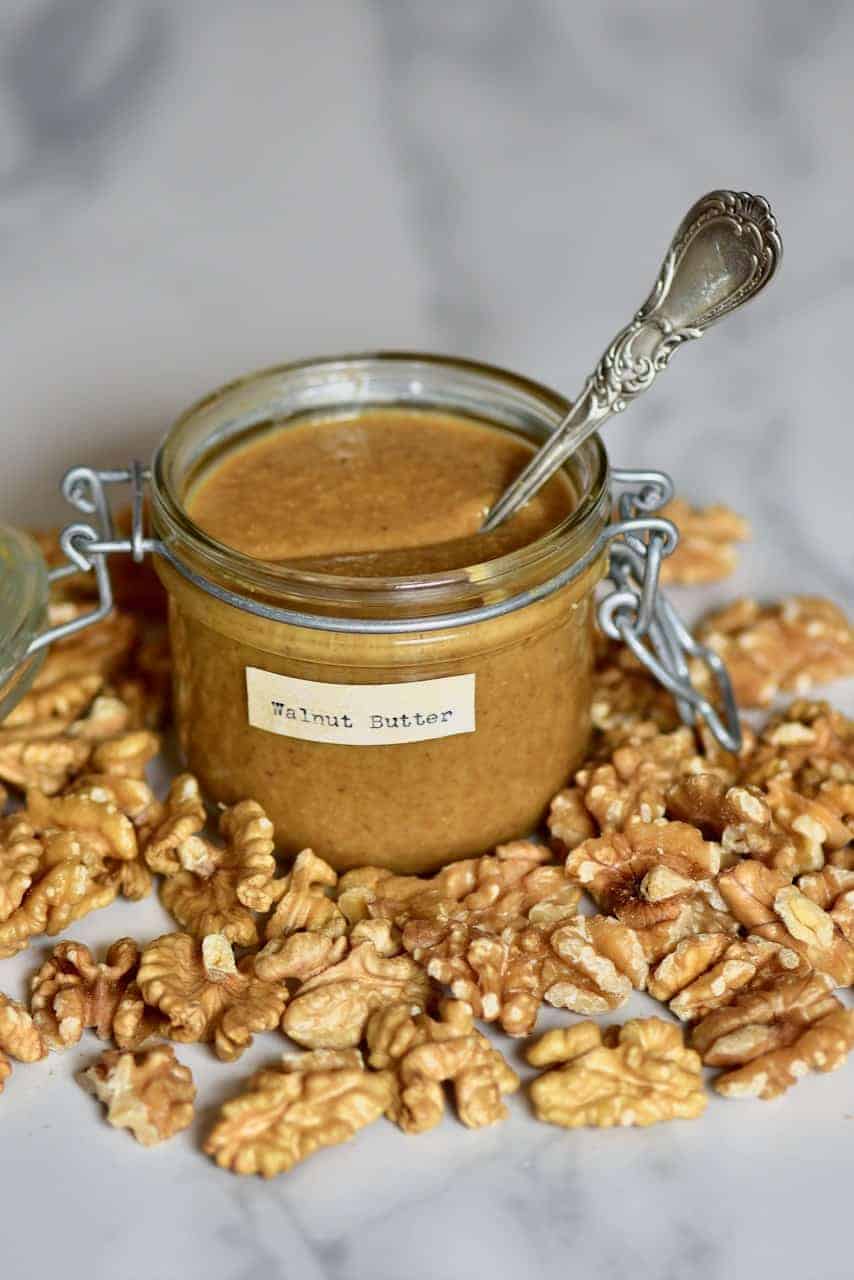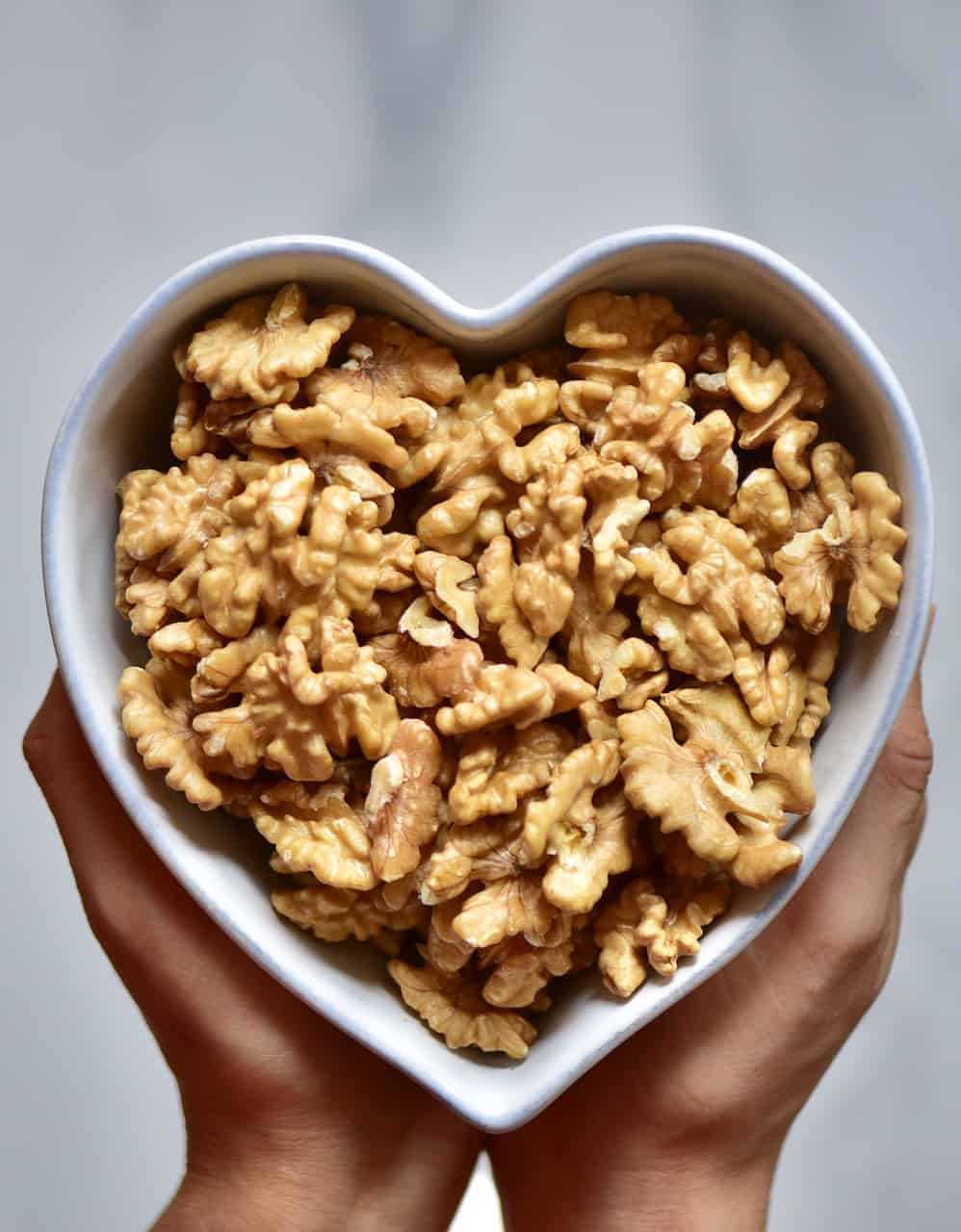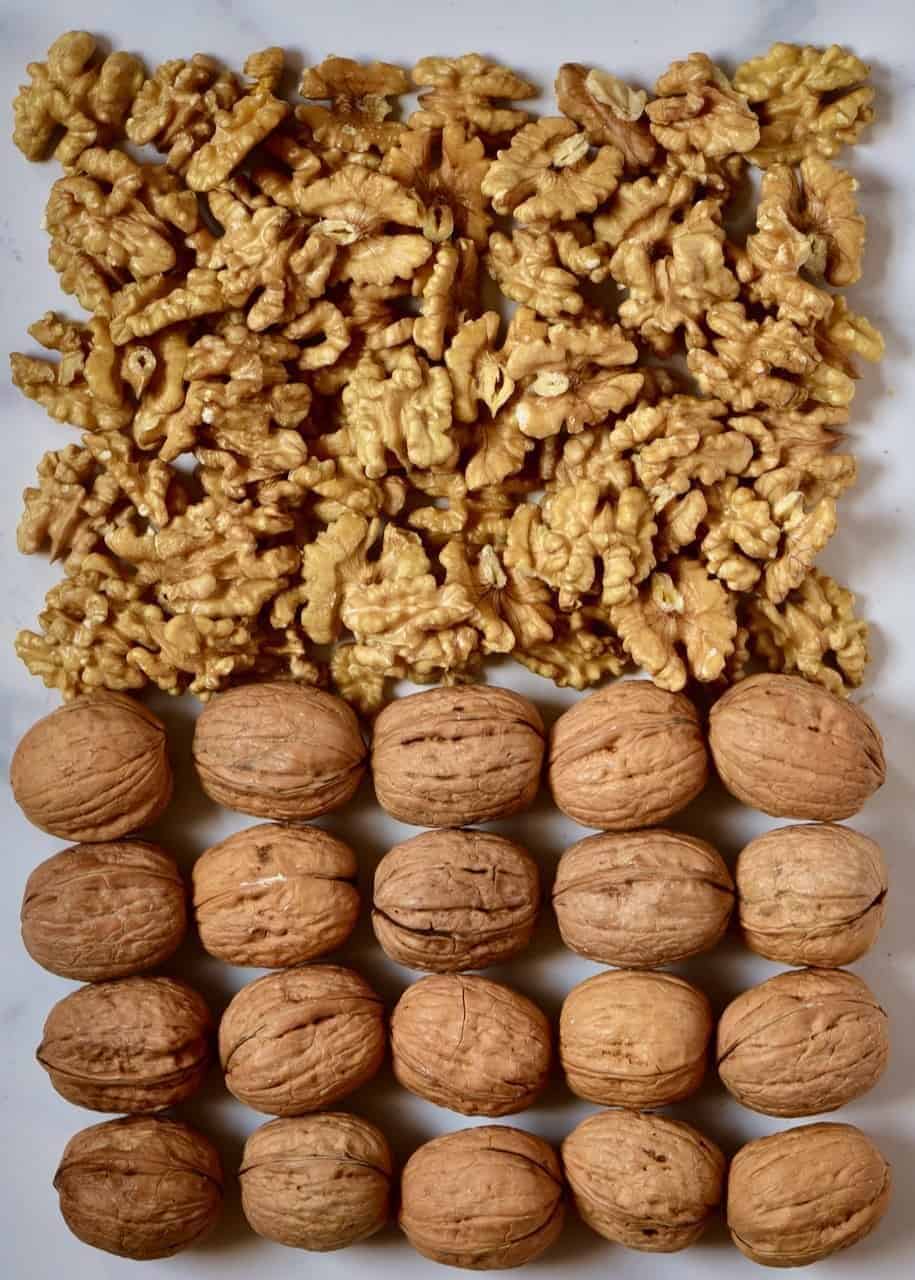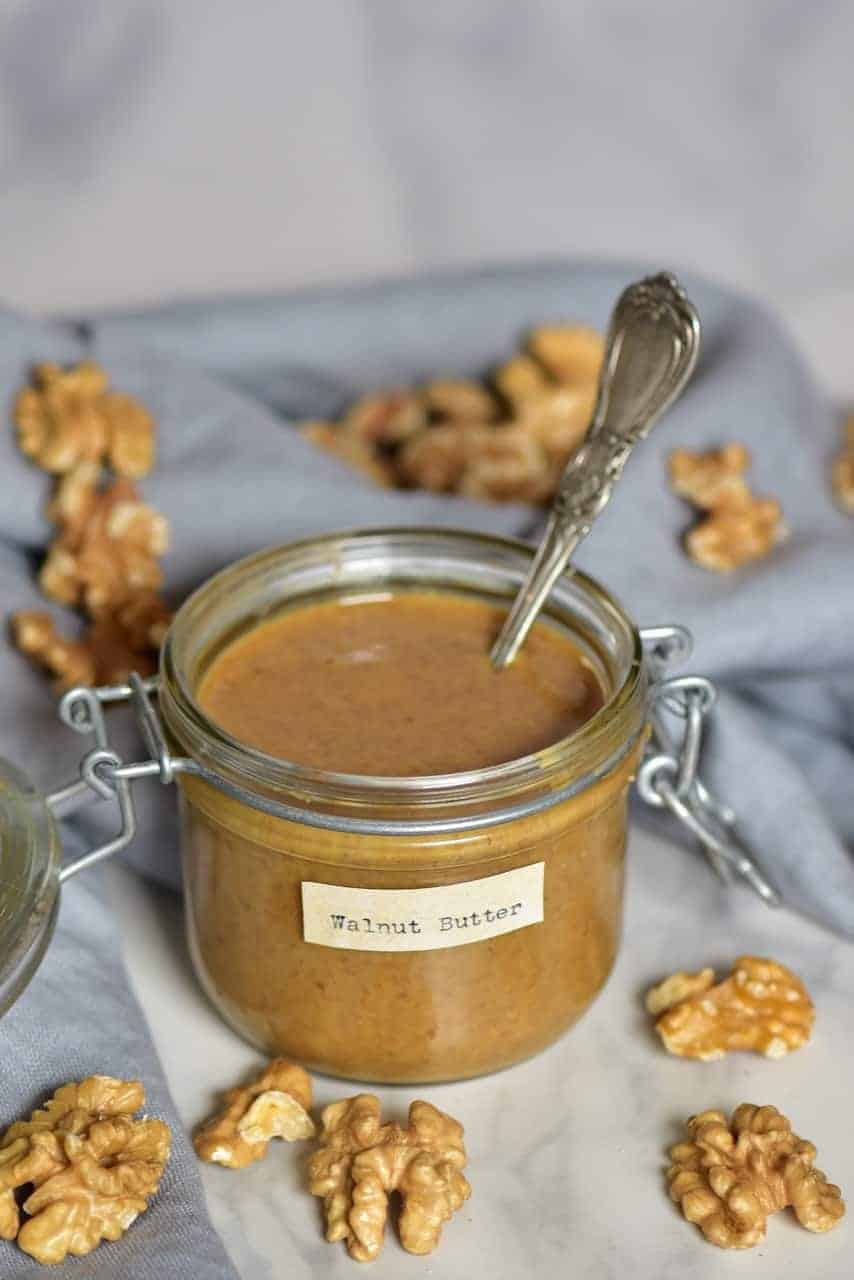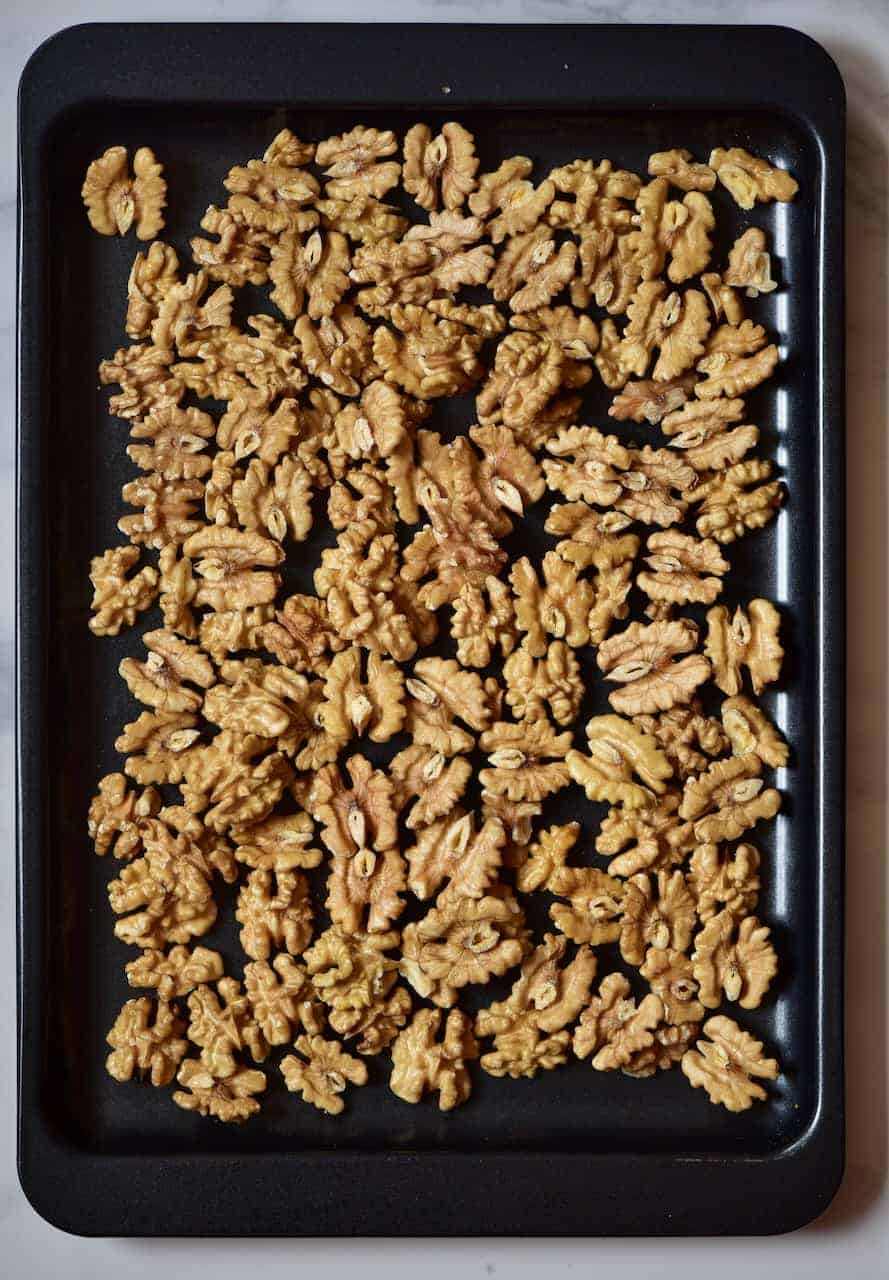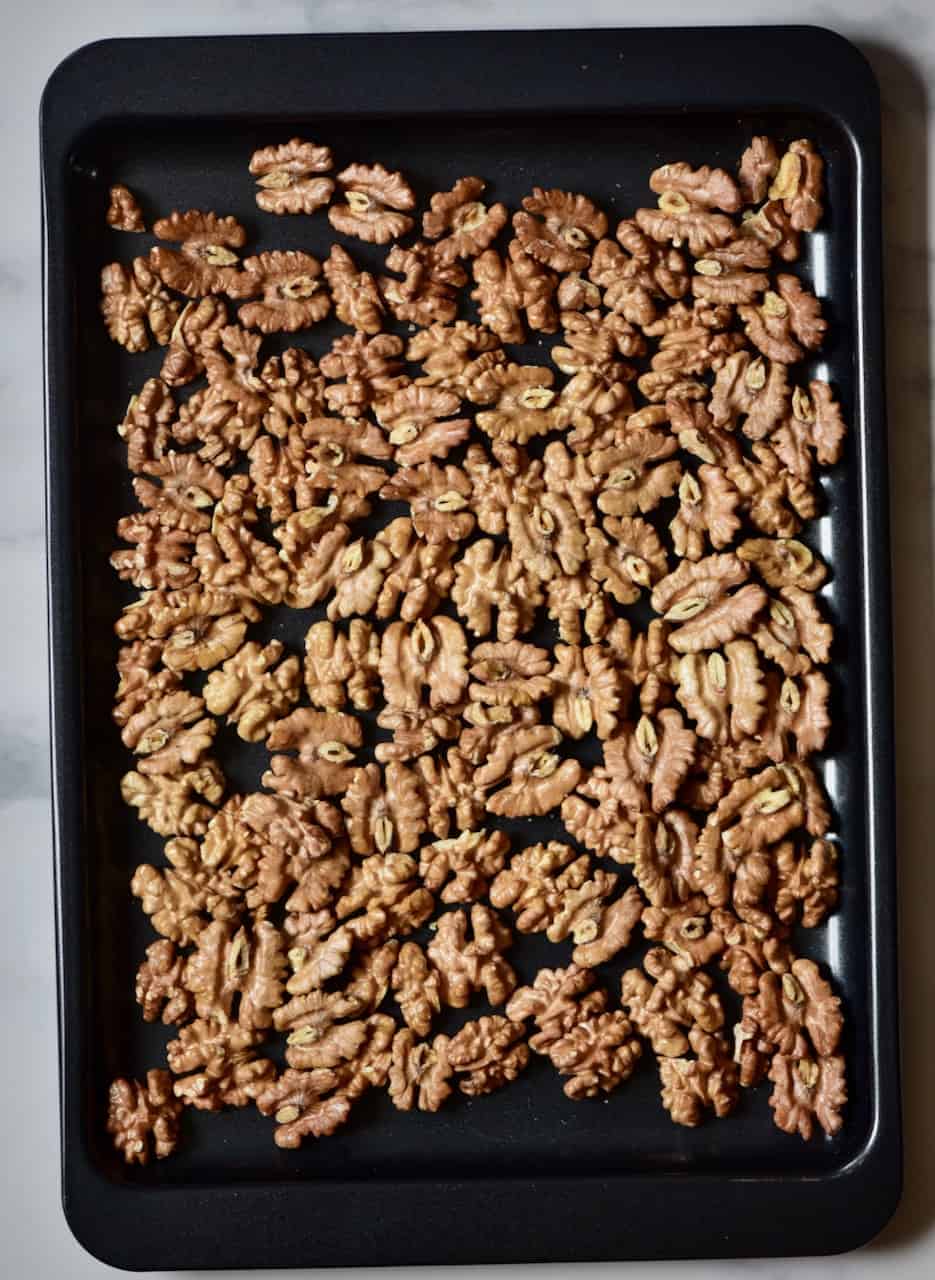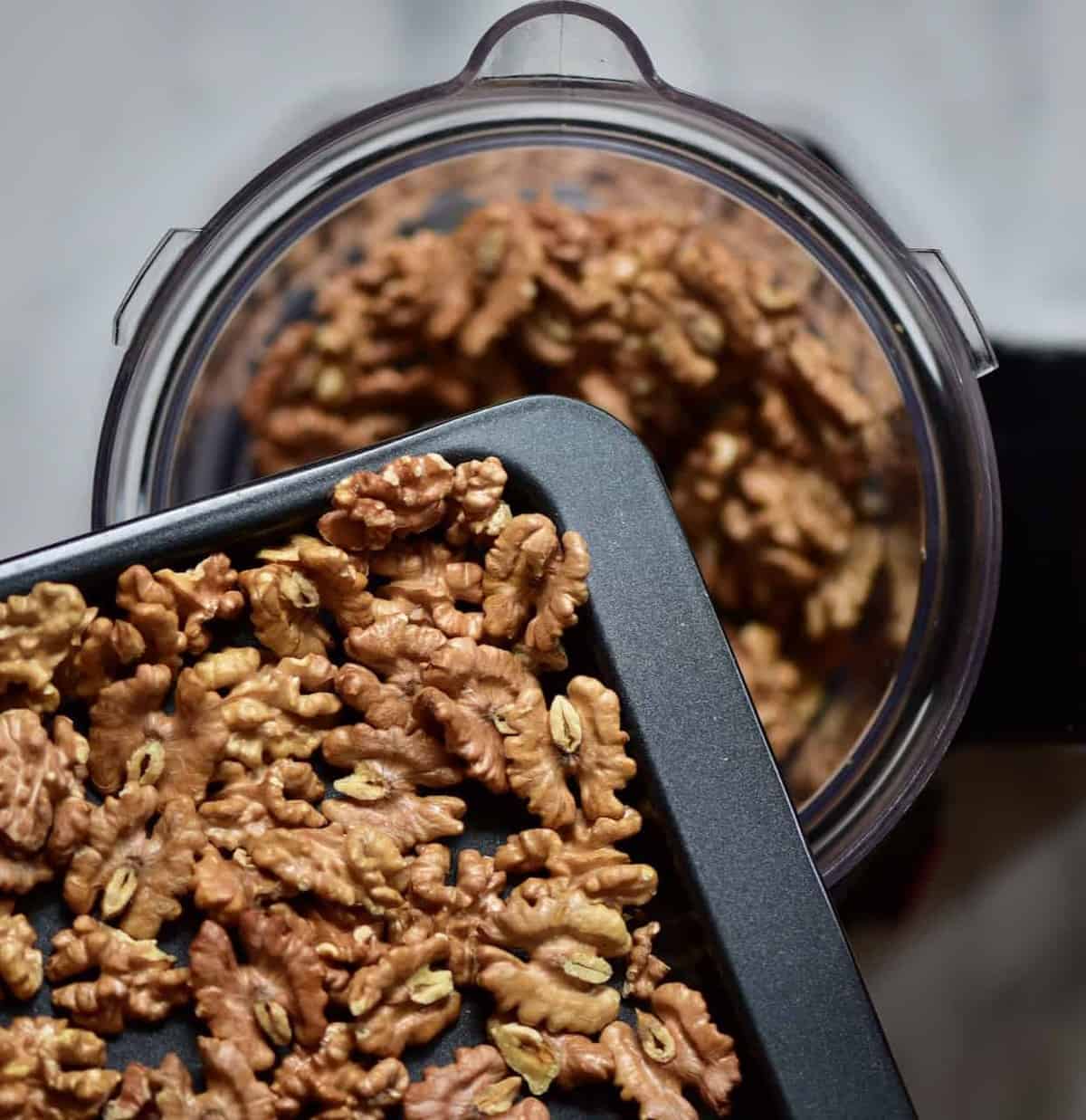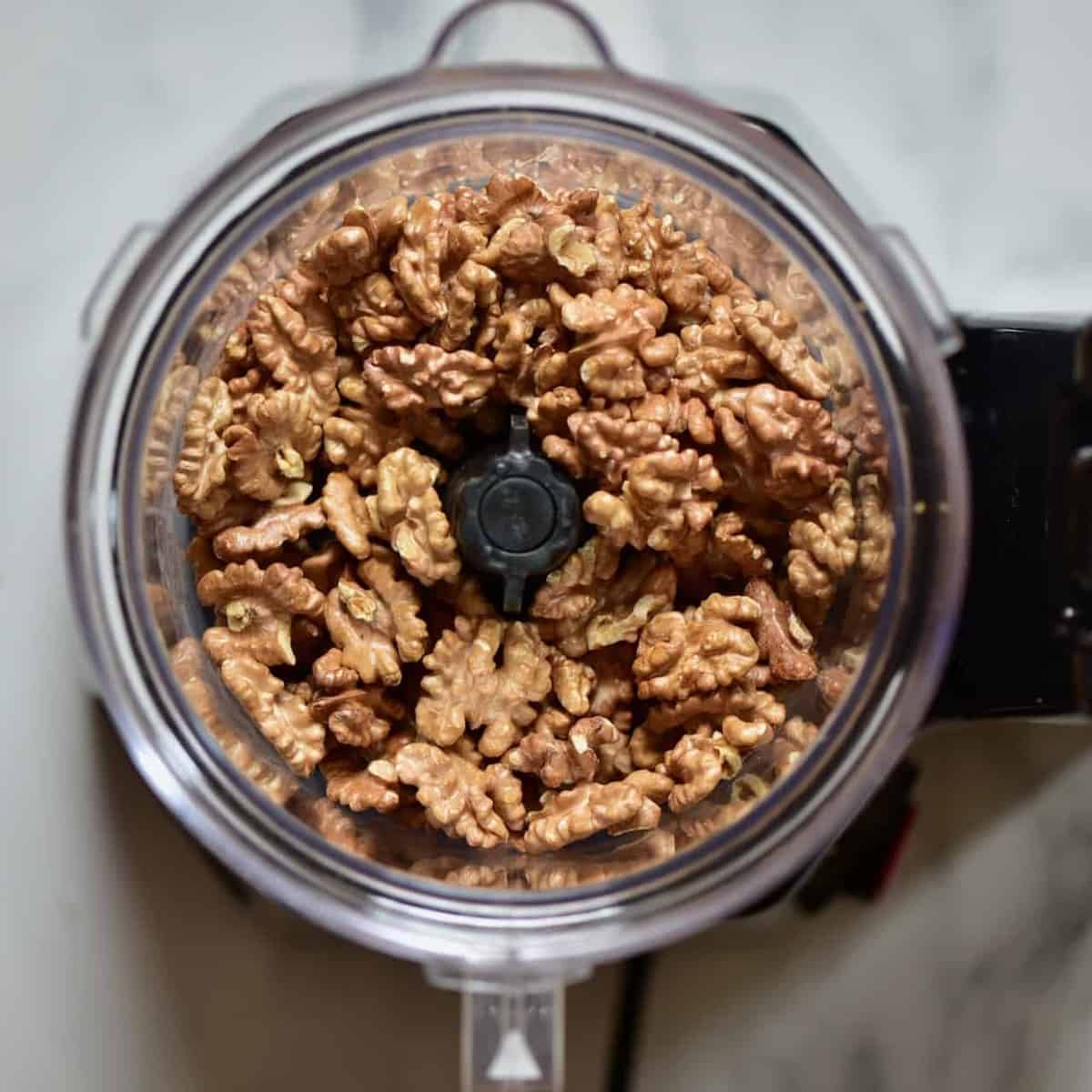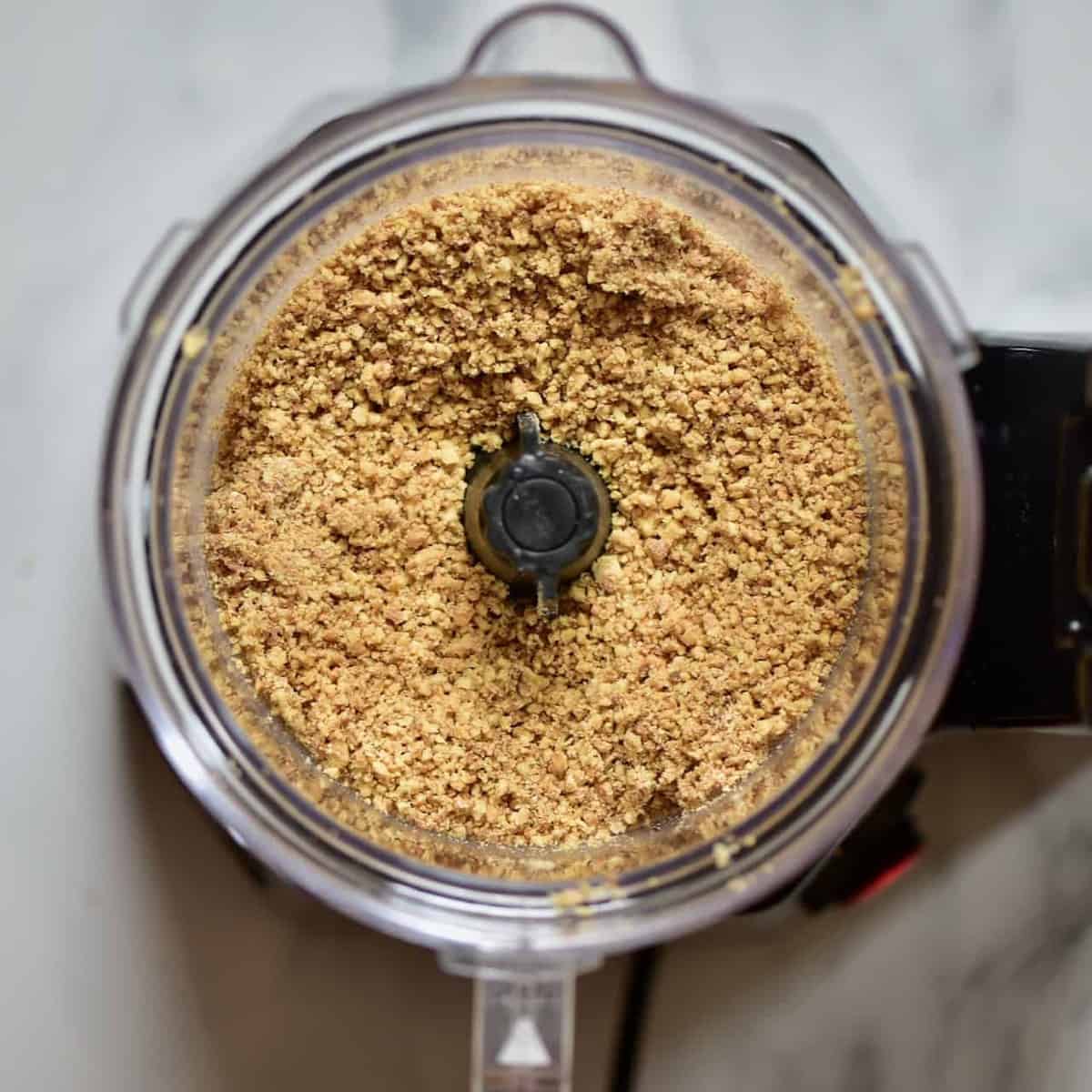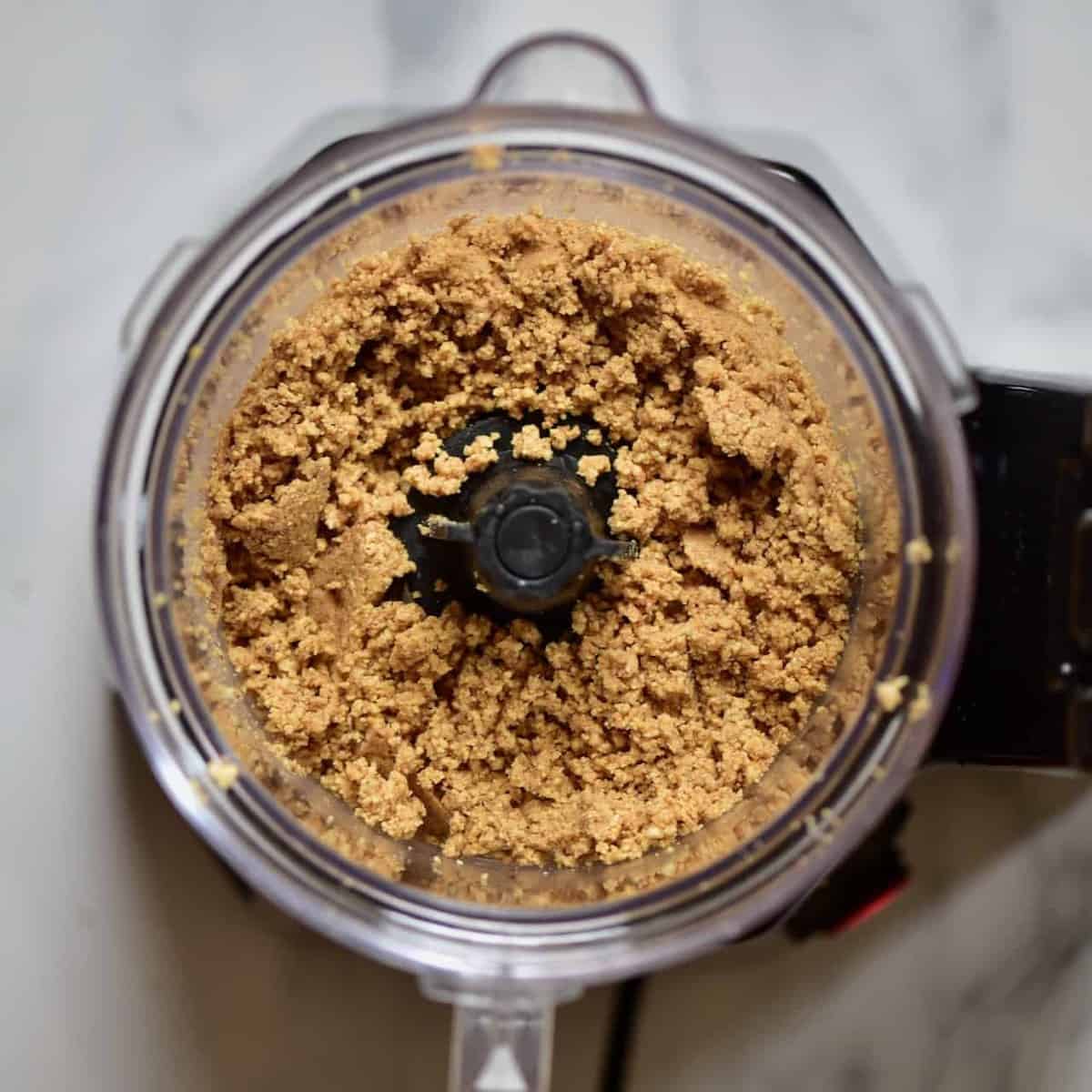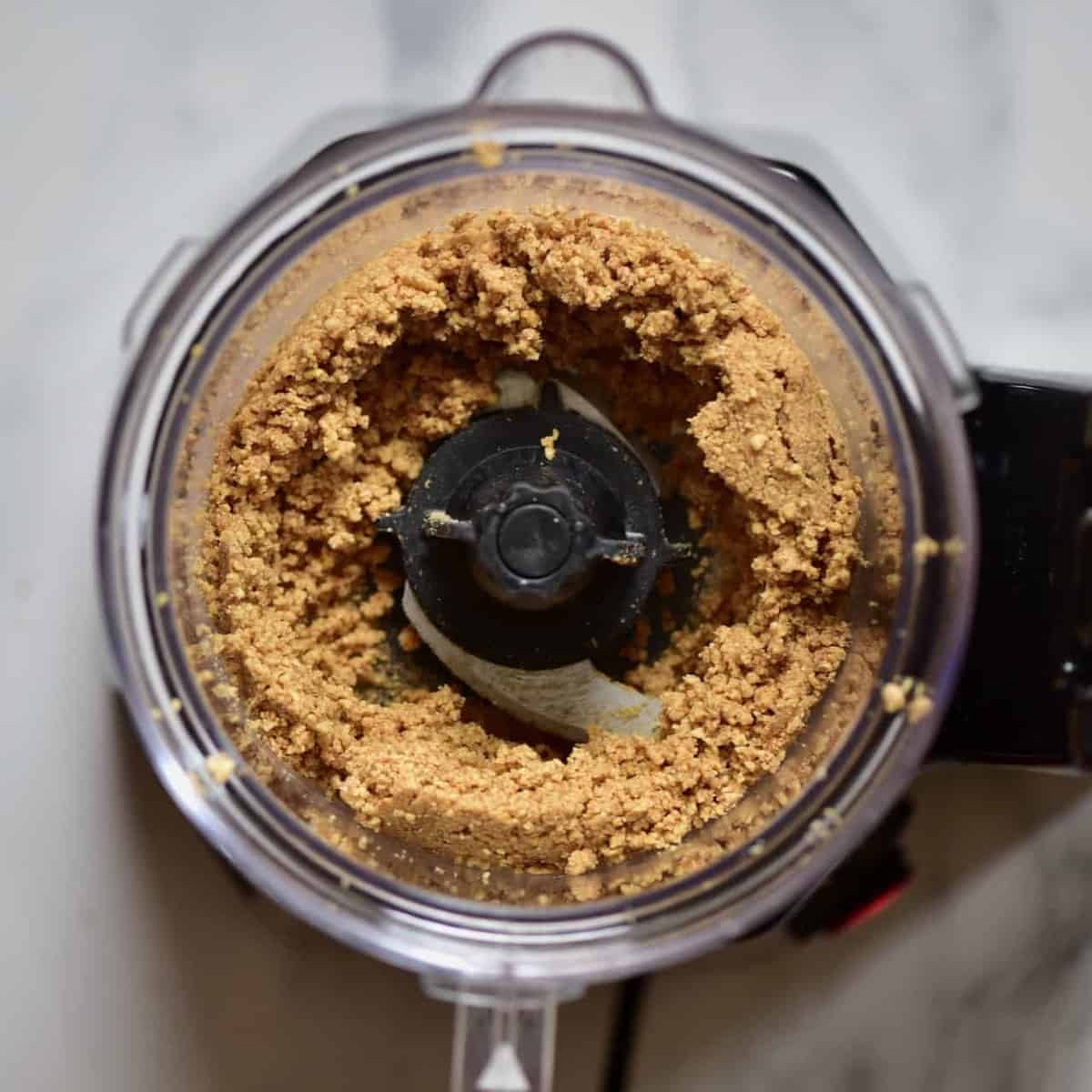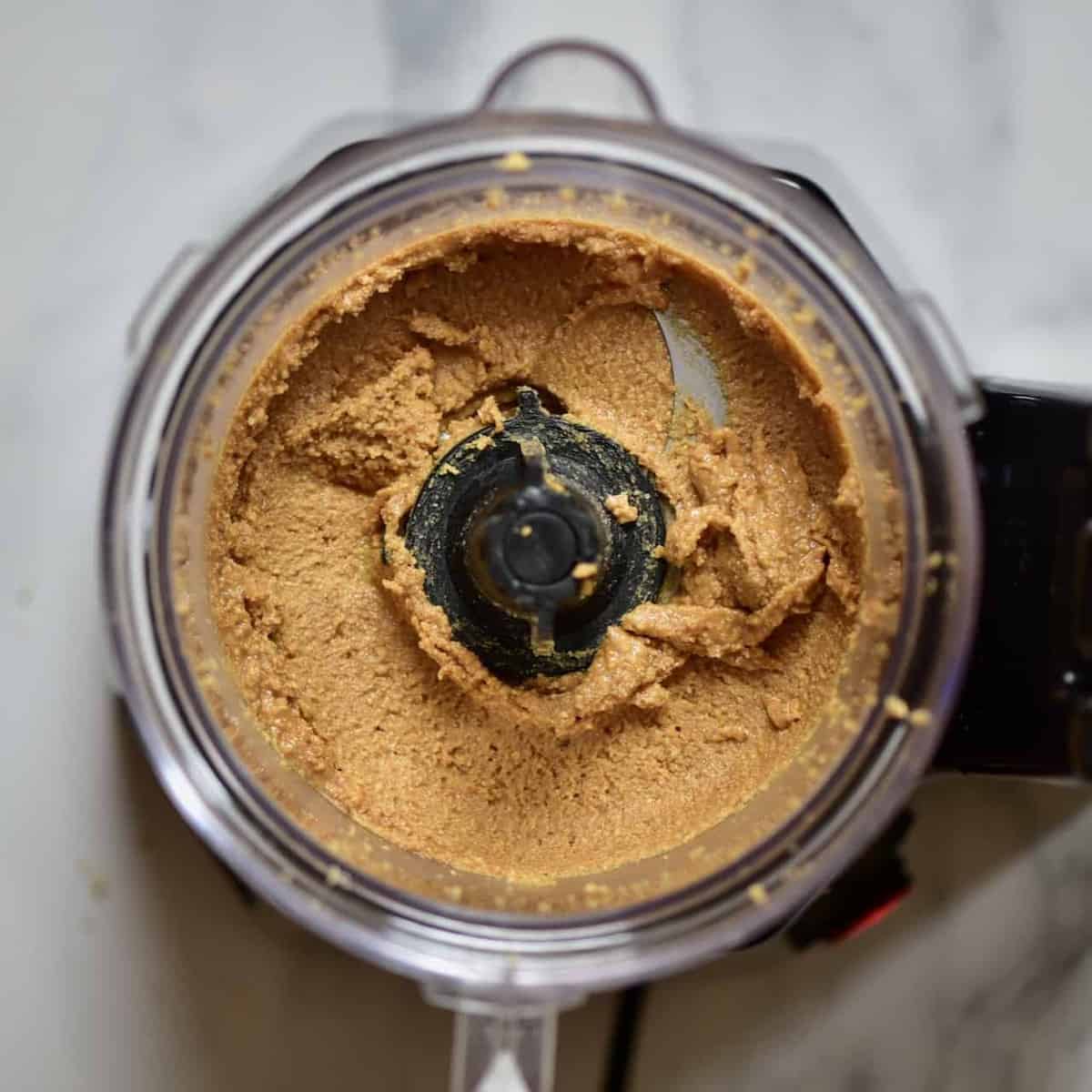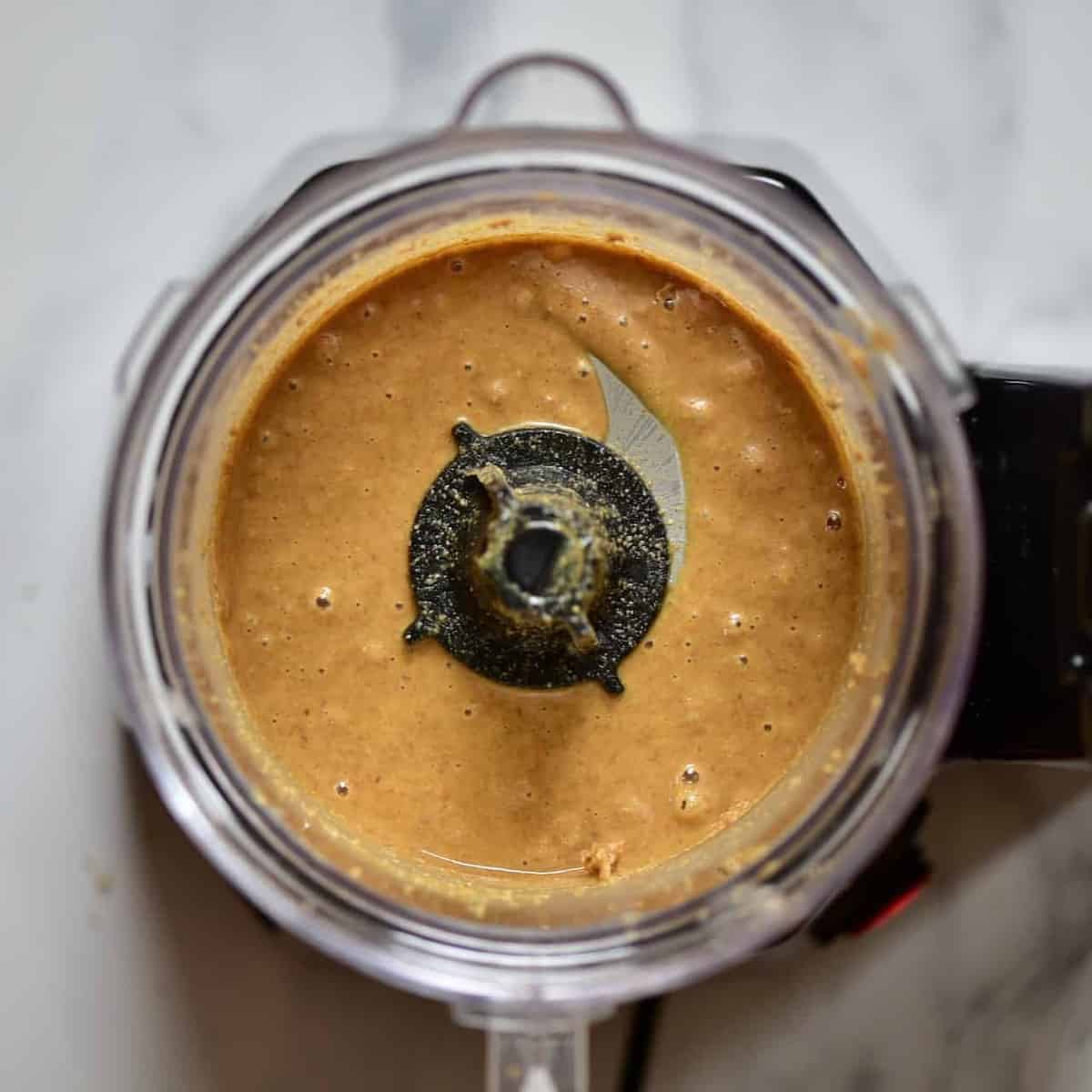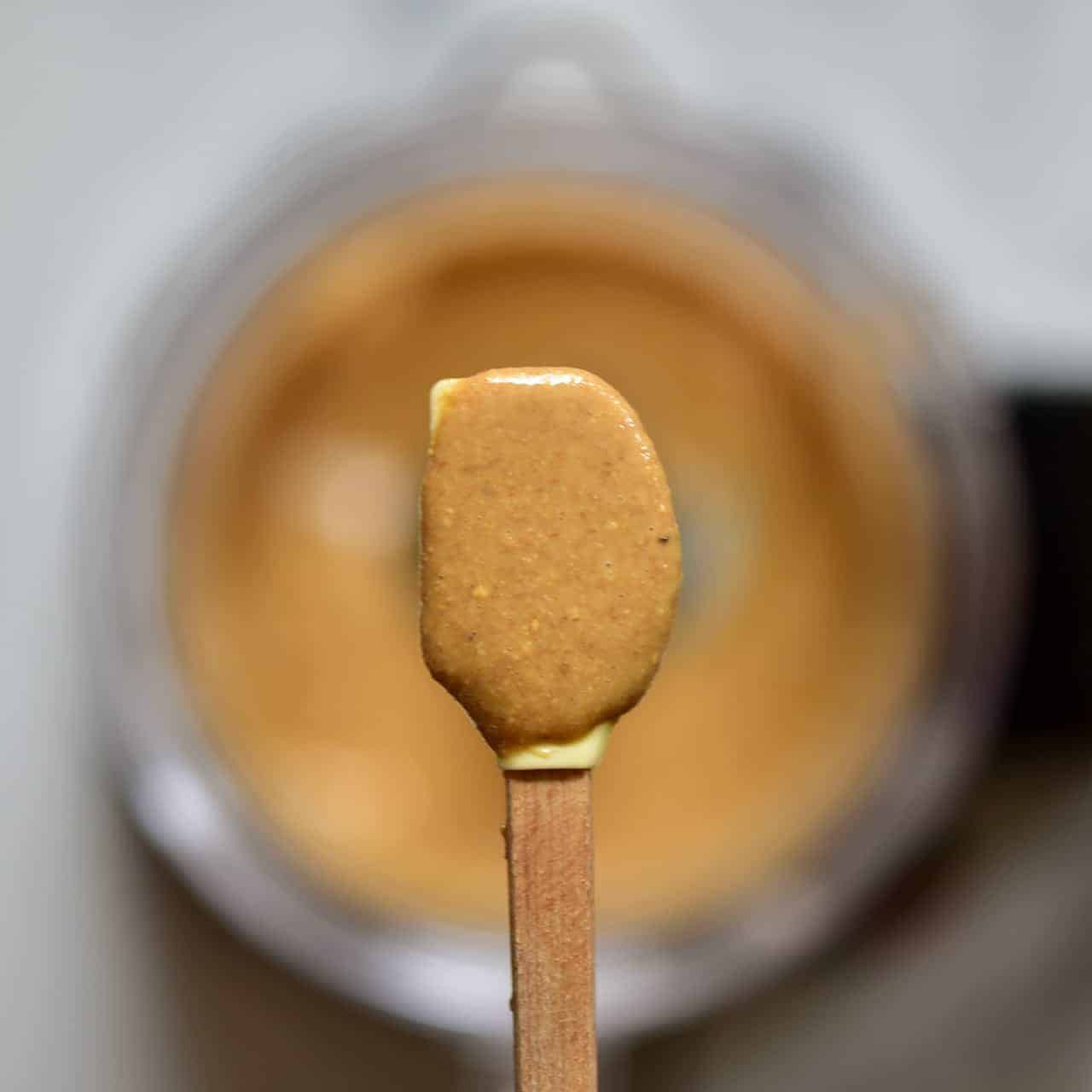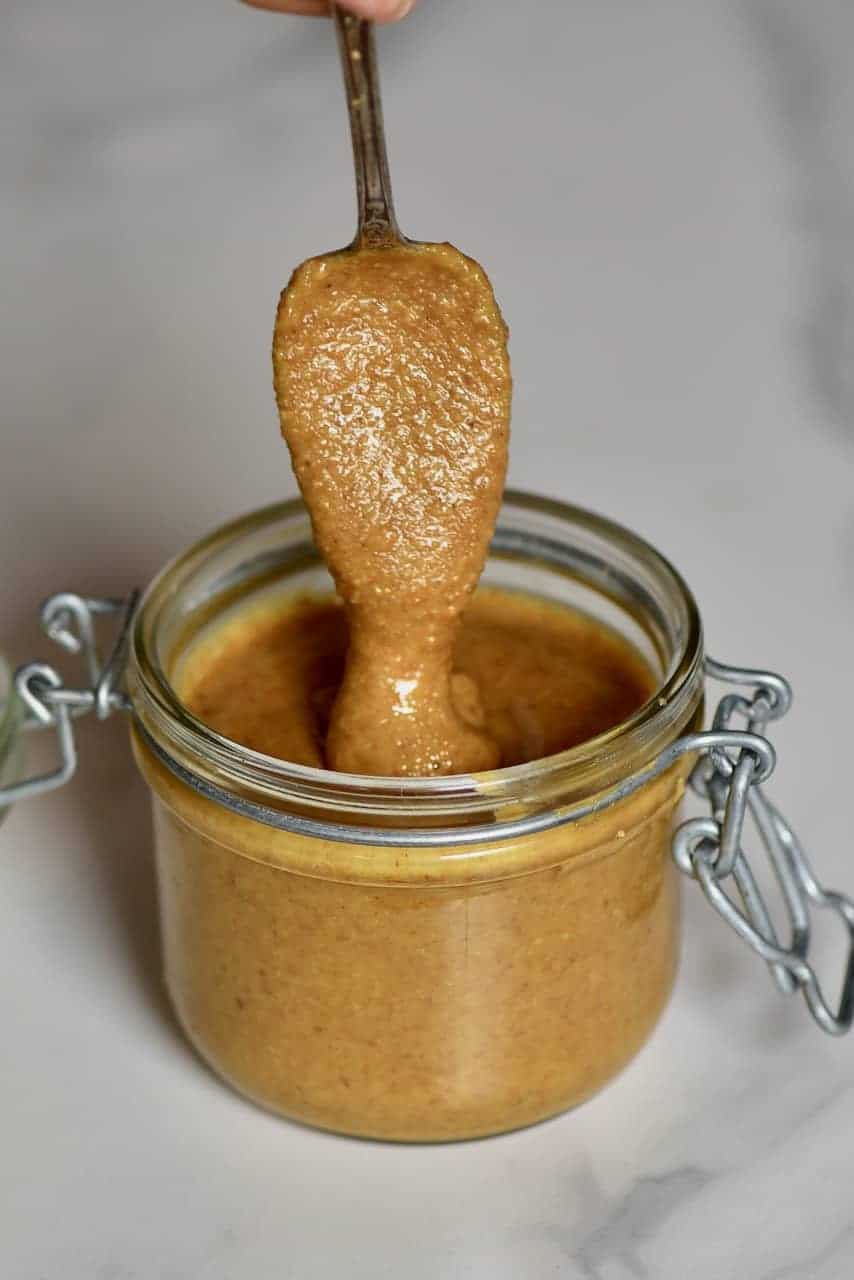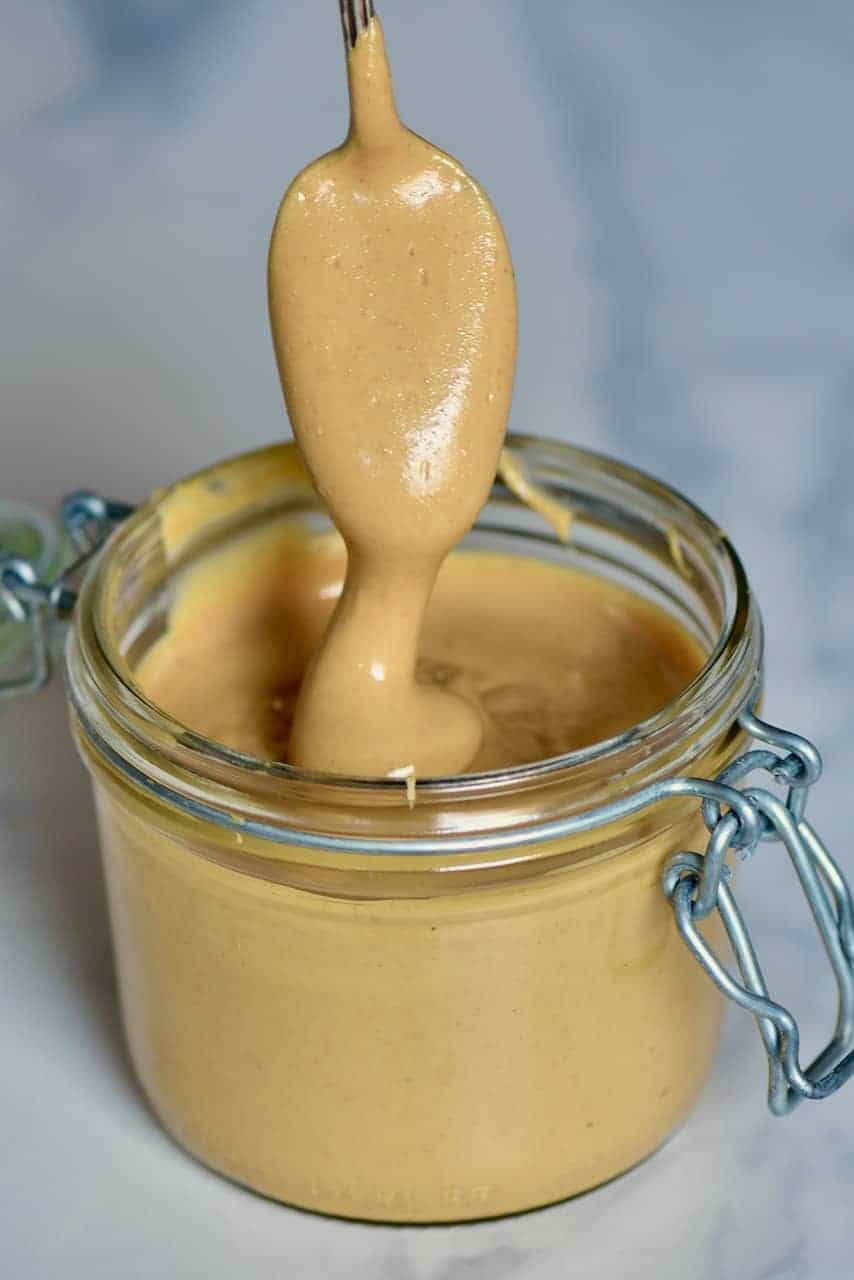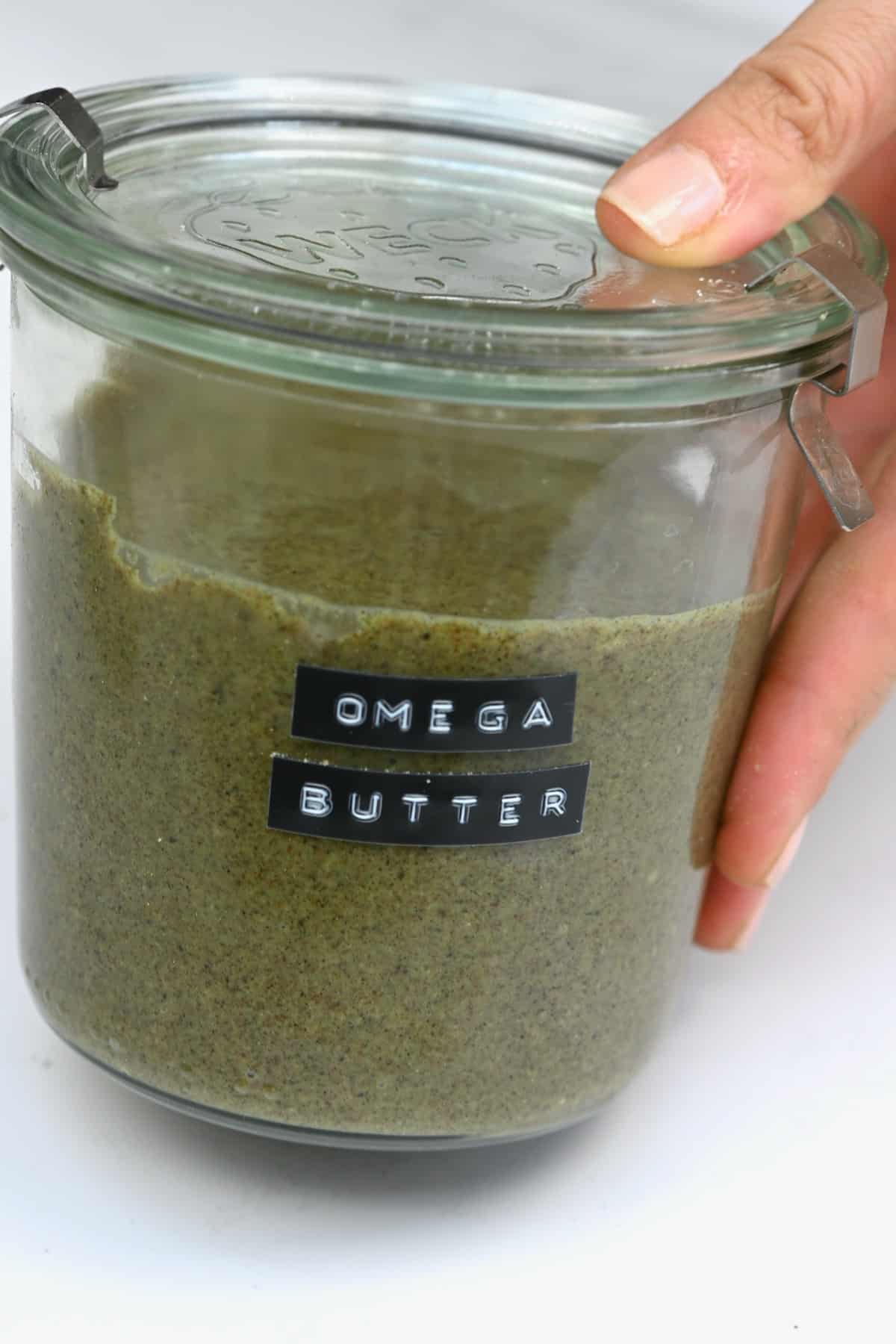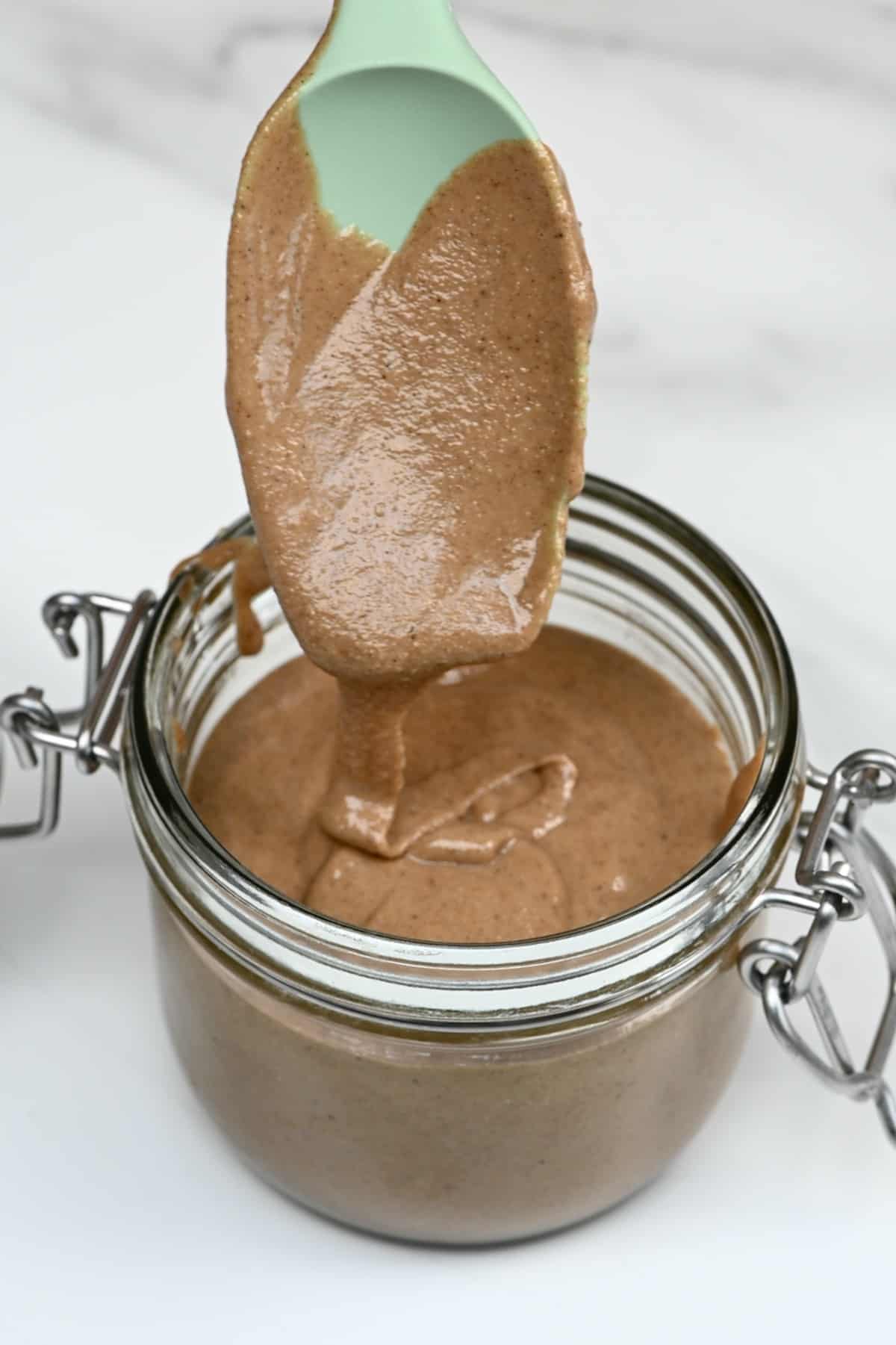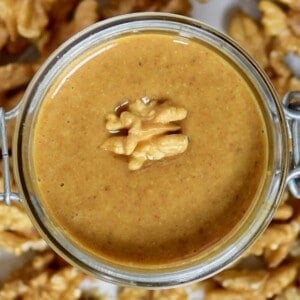This homemade walnut butter recipe was originally posted in December 2019 but has been updated as of October 2021 with some extra notes, tips, uses, and flavor varieties! With popular options like peanut butter, cashew butter, and almond butter taking up the market, it seems like there isn’t much space for homemade walnut butter. However, if you’ve never tried this creamy, buttery, silky-smooth nut butter before then, you’re missing out! It’s even smoother, more buttery, and runnier than all of those! If anything, of all the nuts I’ve blended into butter so far, walnut seems like the VIP addition. It might just be the fact that walnuts always conjure images of walnut whips, and chocolate liqueurs, and Christmas nutcrackers – but this seems like a special occasion nut butter. And yet, you can whip up a delicious silky-smooth batch of raw, soaked, or roasted walnut butter at home right now! All you need is walnuts and a high-speed food processor or high-speed blender!
Smooth and Buttery Homemade Walnut Butter
Not on is this base walnut butter recipe incredibly nutritious (plus with no added oils! No sugars! Optional salt!), but I’ve included a ton of options below on how to add flavor to this creamy nut butter, too, if preferred! Perfect for enjoying yourself or wrapping up as an edible Christmas gift! Even better, since this nut butter still isn’t widely available in stores (And when it is, the price tag is shocking), it makes even more of a treat! Did I happen to mention that walnuts are also one of the most nutritious nuts to make butter with?! Keep reading for a little insight into their health benefits! Then we’ll hop straight into how to make walnut butter with raw walnuts, roasted, and soaked (aka sprouted) – no matter what your diet or health concerns! For even more “lesser known” nut butter recipes – you might also enjoy this brazil nut butter, hazelnut butter, or pistachio butter. Scroll to the bottom of the page for even more!
Health Benefits of Walnuts
Like all nuts, Walnuts are a brilliant source of good fats – including monounsaturated and polyunsaturated fats. However, they are also an excellent plant-based source of Omega-3 and contain iron, calcium, zinc, selenium, Vitamin E, and even some B vitamins.
Walnuts are more abundant in antioxidants than most nuts. Fighting free radicals and oxidative damage to the body. They also reduce harmful LDL cholesterol and contain anti-inflammatory polyphenols.This can decrease the risk of many inflammatory chronic diseases, including heart disease, cancer, diabetes etc. It is also great for brain healthThe Omega-3s within walnuts can help reduce the risk of heart disease as well as beneficial for many mood disorders. Walnuts are a great plant-based source of omega-3Walnuts can improve your gut health – which in turn can influence your overall health and many gut and digestive issues.
Now, on to the homemade walnut butter recipe, flavored walnut butter combinations, and walnut butter recipes/ uses!
What You’ll Need
Walnuts: you’ll need raw, unsalted walnuts for this homemade walnut butter – no matter which method you plan to make (raw, soaked, roasted walnut butter).
You could use pre-roasted walnuts (unsalted) in a pinch. However, they won’t be as easy to blend and could require adding extra oil to the recipe, which I like to avoid.
Salt: technically optional, but a pinch of salt does wonders for enhancing the natural flavor of the walnuts. It’s also great for neutralizing some of the natural bitterness in walnut butter. A food processor or high-powered blender: Even with a high-powered machine, it takes a lot of patience when making any homemade nut butter. If you do attempt this walnut butter recipe with a mid-level machine, it could take double the time and will require lots of breaks (so you don’t overheat the engine).
And that’s it for the “base” walnut butter recipe. However, keep reading for some fun ways to experiment with flavor.
How to Flavor Walnut Butter?
Walnut butter is super buttery, smooth, and creamy – but also slightly bitter. Unlike other nut butter, the unflavored nut butter may not have you reaching for a spoon to eat it directly from the jar. However, with tons of add-ins to choose from, feel free to experiment and find your new obsession!
How to Sweeten Nut Butter?
This deserves a section of its own because there are a couple of rules when it comes to sweetening nut butter without causing it to seize: Liquid sweetener: don’t add a cold sweetener to warm, just-blended nut butter. Instead, wait for it to cool down/ chill to the same temperature as your sweetener and gently fold it in. Alternatively, you can toss the nuts in the sweetener before roasting – that way; they’ll be the same temperature when blending. I’ve used maple syrup and honey with excellent results before. Granulated sugar: It’s important to note that the sugar won’t “dissolve,” so if you’re able, I recommend grinding your sugar of choice into powdered sugar (this won’t work with all sugars or sweeteners, but quite a lot include regular, coconut sugar, etc.) You can also use sugar-free sweeteners (liquid or granulated/powdered). I haven’t yet tried with date paste, but I imagine that would work too.
Other Flavor Options
Nut blends: fFeel free to use a blend of two nuts. I’ve only tried walnut-cashew butter (which was delish!) so I can’t guarantee the best blends. Experiment; pecans, almonds, brazil nuts, etc. Homemade Vanilla extract or Vanilla Powder is a simple way to add extra flavor (and pairs well with lots of other flavor options below). Spices: cinnamon, pumpkin spice, gingerbread spice, and chai spice would all work with walnut butter. Use around 2/3-1tsp then increase to taste. Maple walnut butter: if you can, use maple sugar to avoid the risk of potential seizing. Start with one tablespoon and increase to taste (2 tbsp is my sweet spot). Optionally, add a little Vanilla extract or Vanilla Powder and/or ground cinnamon. Espresso Walnut: similar to how I made this coffee Peanut Butter, but with walnuts. Chocolate walnut butter: you can either add cacao powder (2-4 Tbsp) and your sweetener of choice the walnut butter (but it will be thicker) OR use 1/3-1/2 cup chocolate chips, melt them, and mix into the nut butter.I recommend adding a teaspoon of vanilla extract and a pinch of salt, too. Add a pinch of espresso powder too, to enhance the chocoalte flavor.Dried fruit: an easy way to add extra flavor is by adding freeze-dried fruit. Walnut butter pairs particularly well with apple and banana. I recommend using apple, cinnamon, and maple or another sweetener for a delicious fall walnut butter recipe.
Make sure to add any flavorings after the butter is creamy and smooth, and aim to use flavored varieties within two weeks as the shelf life changes.
How to Make Walnut Butter
Below you’ll find the methods for raw walnut butter, roasted walnut butter (the regular option- photographed), and how to soak walnuts for “sprouted” walnut butter.
For Sprouted Walnut Butter (aka Soaked Walnuts)
There are several reasons why you might want to soak the nuts before preparing the walnut butter. These include:
Soaking reduces the phytic acid in the nut – thus improving the absorption of minerals and nutrients. It also reduces other ezyme inhibitors. Reduces tannins (which causes a bitter flavor, so great to reduce!) and plyphenolsIt even removes gas-causing compounds within the nuts to avoid bloat and gas issues.
Best of all, the process of soaking the nuts is very simple – but requires quite a bit of time.
The Process
Step 1: Soak the Walnuts: Add the nuts to a bowl and cover with water, then leave to soak overnight. In the morning, drain the water, and rinse the nuts. Step 2: Dry the walnuts: First, pat them dry with a clean kitchen towel. Then spread them across a baking sheet and bake in the oven at 350F/180C for 15-20 minutes, or until dry, lightly toasted (fragrant), and slightly darker in color. Allow the nuts to cool for several minutes before processing. Alternatively, if you want to keep the recipe “raw,” you can use a dehydrator at 40ºC/104ºF to dry the nuts. This can take up to 24 hours (check at 12h and every couple hours after until fully dry). The nuts must be completely dry before processing (keep reading below for processing steps).
For Roasted Walnut Butter
Roasting the walnuts not only enhances their flavor but helps to extract the natural oils from the nuts, making them easier to blend, with no extra oil necessary (and minimal prep time). To do so:
Step 1: Roast the walnuts
Spread the walnuts in a single layer on a baking tray and toast in a pre-heated oven at 165ºC/325ºF for 8-10 minutes, or until fragrant and slightly darker in color. Then remove them from the oven and allow them to cool until just slightly warm (this will help them blend easier, but too hot and they can ruin the blades in your machine and cause it to overheat).
Step 2: Process the Walnut Butter
The following steps can now be done with your soaked, raw, or roasted nuts
Transfer the walnuts to the bowl of a food processor (or blender, but a processor is best) and blend until it reaches your desired consistency. This can take as little as 3 minutes up to 15, depending on what nuts (raw vs. roasted) and your machine. For me, it took 10 minutes for super smooth and runny walnut butter (breaks included).
Make sure to give your machine a break every two minutes, scrape down the sides with a spatula, and then process for longer. The nuts will first break into a crumb-like consistency, then a thick chunky paste, smoother paste, before becoming soft, drippy, and silky smooth! If you’re using raw walnuts: these will take longer to process since the roasting process causes the oils to start releasing from the nuts. For these, you’ll have to be patient and give your machine lots of breaks. If it doesn’t go past the thick crumb/ball stage, you may need to add 1-2 tablespoons of your desired oil (like coconut oil, avocado oil, or mild olive oil). Once blended to your desired consistency, you can pulse in any add-ins OR transfer it to an airtight jar.
How to Store
Store: store the walnut butter in an airtight glass jar in the fridge for between 6-8 weeks. Make sure to use a clean utensil any time you use the nut butter and stir it to redistribute the oils within. Note that if you’ve added in any sweetener or other add-ins, it will impact the shelf life, and I recommend using it within 1-2 weeks! Freeze: you can also freeze the walnut butter for up to 4 months. Either store it in a freezer-safe container (with headspace) OR save it in portions in an ice cube tray.
How to Use Walnut Butter?
Spread over bread – like regular toast, bagels, simit, sandwiches, etc. or even cake – like banana bread.Spoon into your oatmeal or overnight oats.Drizzle over pancakes or waffles (I like to use sweetened walnut butter when doing so).Mix into smoothies and smoothie bowls.Use to make ice-cream.Delicious fat balls/ energy balls.Use within tart fillings.Add into cookies, cake, and brownies recipes.Use to stuff dates.Protein bars and granola bars.Use in place of PB in homemade Vegan peanut butter cups.Use to make “cheat” walnut milk. Just combine one tablespoon of walnut butter with one cup water and blend for 10-15 seconds, or until creamy.
Let me know in the comments how you like to enjoy your homemade walnut butter!
Recipe Top Tips and Notes
Use enough nuts: Make sure that you’re using enough nuts in your food processor to comfortably completely cover the blade (3 cups is the minimum for me). If you want to make a very small amount, you could use a coffee/spice grinder. Adjust the thickness: The easiest way to do this is simply by processing it for a shorter vs. longer time.Be patient: Every nut butter goes through several stages when blending into a nut butter. Unfortunately, it can sometimes seem like the nuts don’t want to move past the thick paste/pre-paste stage. But give your machine breaks and keep trying. If, after another 3-4 minutes, it still hasn’t budged – it’s time to rely on a tablespoon of oil. You shouldn’t need this though (especially when using roasted walnuts). Use a food processor when possible: I’ve found they work best unless you have a very powerful blender.Use any add-ins at the end: Make sure the walnut butter is the consistency you want before pulsing/ folding in any extra flavorings/add-ins. And remember to enjoyed flavored walnut butter within 2 weeks!To remove some fat: If you want to reduce some of the fats in the walnut butter, you can wait until the oils and nut pulp separate as it sits and then simply scoop some of the oil out of the jar. Just note that this will make the but butter thicker/not as smooth.
Other Nut and Seed Butter Recipes
How to Make Homemade Cashew ButterSuper Omega Seed Butter (5-Seed Butter)How To Make Granola Butter (Oatmeal Butter)Homemade Sunflower Seed Butter (Oil-Free)Simple Homemade Pistachio ButterDIY Homemade Vegan Nutella RecipeCoffee Peanut Butter Spread (Espresso Spread)
As always, if you give this homemade walnut butter recipe a try, let me know your thoughts and questions in the comments below. Also, feel free to tag me in your recreations @AlphaFoodie.
